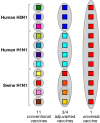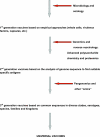Universal vaccines: shifting to one for many
- PMID: 20689748
- PMCID: PMC2912660
- DOI: 10.1128/mBio.00042-10
Universal vaccines: shifting to one for many
Abstract
Human vaccines, with their exquisite antigenic specificity, have greatly helped to eliminate or dramatically abate the incidence of a number of historical and current plagues, from smallpox to bacterial meningitis. Nonetheless, as new infectious agents emerge and the number of vaccine-preventable diseases increases, the practice and benefits of single-pathogen- or disease-targeted vaccination may be put at risk by constraints of timely production, formulation complexity, and regulatory hurdles. During the last influenza pandemic, extraordinary efforts by vaccine producers and health authorities have had little or no influence on disease prevention or mitigation. Recent research demonstrating the possibility of protecting against all influenza A virus types or even phylogenetically distant pathogens with vaccines based on highly conserved peptide or saccharide sequences is changing our paradigm. "Universal vaccine" strategies could be particularly advantageous to address protection from antibiotic-resistant bacteria and fungi for which no vaccine is currently available.
Figures


References
-
- Tan Q. T. 2010. Serious and invasive pediatric pneumococcal disease: epidemiology and vaccine impact in the USA. Expert Rev. Anti Infect. Ther. 8:117–125 - PubMed
-
- Henderson D. A., Brooke C., Inglesby T. V., Toner E., Nuzzo J. B. 2009. Public health and medical responses to the 1957-58 influenza pandemic. Biosecur. Bioterror. 7:265–273 - PubMed
LinkOut - more resources
Full Text Sources
Other Literature Sources
